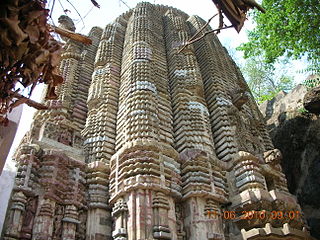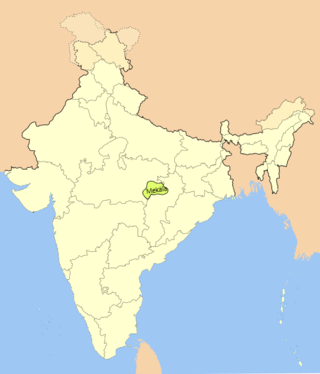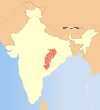
Chhattisgarh is a landlocked state in Central India. It is the ninth largest state by area, and with a population of roughly 30 million, the seventeenth most populous. It borders seven states – Uttar Pradesh to the north, Madhya Pradesh to the northwest, Maharashtra to the southwest, Jharkhand to the northeast, Odisha to the east, Andhra Pradesh and Telangana to the south. Formerly a part of Madhya Pradesh, it was granted statehood on 1 November 2000 with Raipur as the designated state capital.
Rajnandgaon is a city in Rajnandgaon District, in the state of Chhattisgarh, India. As of the 2011 census the population of the city was 163,122. Rajnandgaon district came into existence on 26 January 1973, as a result of the division of Durg district.

Rajnandgaon is a district of the state of Chhattisgarh in central India. The administrative headquarters the district is Rajnandgaon town.

Korba District is an administrative district of Chhattisgarh state in central India. The headquarter of this district is Korba.

Bargarh District is an administrative district of Odisha state in eastern India. The city of Bargarh is its district headquarters. The district was carved out of the erstwhile district of Sambalpur on 1 April 1993.

Ratanpur is a town and a nagar palika in Bilaspur district in the Indian state of Chhattisgarh. It is located about 25 kilometres (16 mi) from Bilaspur on National Highway 130 towards Ambikapur.

Mahasamund district is a district in Chhattisgarh state in central India. The city of Mahasamund is the district headquarters. The district is particularly famous for the historical temple town of Sirpur besides the Mahanadi river.

Chhattisgarh Division was an administrative division of the Central Provinces of British India. It was located in the east of the Central Provinces and encompassed the upper Mahanadi River basin, in the central part of present-day Chhattisgarh state of India.

The Haihaiyavansi Kingdom, ruled by the Kalachuris of Raipur was a kingdom which consisted of the central part of the present-day state of Chhattisgarh located in India.

Bhunjias, are an ethnic group found in India mainly reside in Sunabeda plateau in Odisha and Chhattisgarh. They are mostly found in Nuapada district, which is roughly between 22° 55′ N and 21° 30′ N latitude and 82° 35′ E longitude. It was a part of Khariar Zamindari, which formed the eastern and the southeastern region of Raipur district of Chhattisgarh division in Central Province till 1 April 1936, when it was transferred to Odisha on its creation. It is now in Komna block of Nuapada district in Orissa. In Chhattisgarh they are found in Raipur district.

Bemetara district is a new district in the state of Chhattisgarh, India.

Gariaband District is one of the 33 districts of Chhattisgarh. It has its headquarters at Gariaband town. The district was carved out of Raipur district in 2012.

Surajpur district is a district in the state of Chhattisgarh in central India, with its administrative headquarters at Surajpur. National Highway 43 passes through Surajpur district. Surajpur was declared a district on 15 August 2011 by the state former Chief Minister Dr. Raman Singh along with eight other new districts. Surajpur is the first district to receive National Satyan Maitra Literacy Award. The district is known for its market and other major tourist places of Chhattisgarh with Tamor Pingla Wildlife Sanctuary.

Baloda Bazar - Bhatapara is a district in Chhattisgarh state of India with its headquarters at Baloda Bazar. Before its creation, it was a part of Raipur district. The border of Balodabazar-Bhatapara district touches Bemetara, Mungeli, Bilaspur, Janjgir, Raigarh, Mahasamund and Raipur districts. According to the prevalent tradition in relation to the naming of the Balodabazar in the past, the traders of Gujarat, Haryana, Maharashtra, Orissa, Barar etc. used to gather in the market buffaloes of the city to sell the buffalo, buffalo (Boda). As a result, its name became popular in the name of the bullboda market and in the form of the Baloda Bazar.

The Kalachuris of Ratnapura were a central Indian dynasty during 11th and 12th centuries. They ruled parts of present-day Chhattisgarh from their capital at Ratnapura. They were an offshoot of the Kalachuris of Tripuri, and ruled as vassals of the parent dynasty for many years.

Gaurela-Pendra-Marwahi district is a district in the Indian state of Chhattisgarh. Gaurella is the headquarters of the district. It was carved out of Bilaspur district and inaugurated in February 2020.
The siege of Ratanpur in 1740 was a siege laid by the Marathas of Nagpur on the fort of Ratanpur, capital of the Haihaiyavanshi Kingdom. There was almost no resistance by the Haihaiyavanshis, which resulted in a Maratha victory.
Mohan Singh was the last ruler of the Haihaiyavanshi Kingdom, the dynasty which ruled Chhattisgarh for over 700 years. He ruled Chhattisgarh under the suzerainty of the Bhonsles of Nagpur Kingdom.

Mekala is a historical region of India, extending from Amarkantak to Balaghat. It corresponds to the Maikal Hills, which comprises the present-day Kawardha District of Chhattisgarh state and Anuppur district of Madhya Pradesh. In the medieval period, the region was ruled by the Panduvamshis of Mekala.
Babu Revaram was a prominent poet and historian of Chhattisgarh, who played a vital role in reconstructing the history of that region. He is known as the "first historian of Chhattisgarh" because he wrote several important historical works such as the Tawarikh Shri Haihaiyavamsa Rajaon ki and Ratanpur Itihas. He also wrote poetic works like Saar Ramayana Deepika and Geeta Madhav. The term "Chhattisgarh" was first used in a historical text by Babu Revaram in his Vikram Vilas, published in 1839.






















